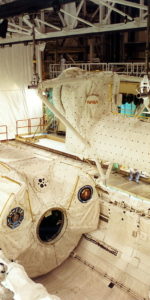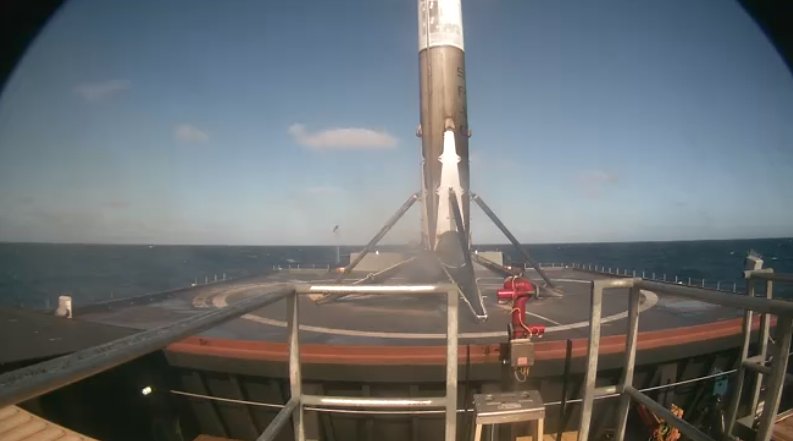
SpaceX has returned to flight operations, with the successful delivery of ten Iridium NEXT global mobile telecommunications satellites to low-Earth orbit. Launch of the Upgraded Falcon 9 took place during an “instantaneous” window at 9:54 a.m. PST Saturday, 14 January, and marked its third flight from Space Launch Complex (SLC)-4E at Vandenberg Air Force Base. Within eight minutes, the first stage completed a smooth touchdown on the Autonomous Spaceport Drone Ship (ASDS), nicknamed “Just Read the Instructions”, which was situated off the coast of San Diego. This marked the first time that the “West Coast” drone ship had hosted a fully successful landing of a Falcon 9 first stage. Aside from the visible triumph of returning to flight and bagging another ASDS landing, however, SpaceX has successfully fulfilled the first part of a seven-year-old contract which will see it place 70 Iridium NEXT satellites into orbit by spring 2018.
“Team Vandenberg takes pride in supporting the launch of Iridium NEXT and SpaceX’s return to flight,” said Col. J. Christopher Moss, 30th Space Wing Commander at Vandenberg and the Launch Decision Authority for the Iridium NEXT mission. “Today’s launch is a testament to the professionalism and commitment to mission assurance, public safety, and mission success on the Western Range.”
A mere 13 months ago, on 21 December 2015, SpaceX returned to nominal flight operations, following the high-altitude loss of a Dragon cargo mission the previous June. A bright 2016 got underway, as SpaceX retired its Falcon 9 v1.1 booster and focused on the Upgraded Falcon 9, which benefits from an enhanced fueling regime and has been able to accomplish the first-ever landing of first-stage hardware on solid ground. Between 17 January and 14 August last year, no fewer than eight Upgraded Falcon 9s—the largest number ever flown by SpaceX within a single calendar year—roared smoothly aloft, delivering six commercial communications satellites to Geostationary Transfer Orbit (GTO), the Jason-3 ocean altimetry spacecraft into low-Earth orbit and a pair of Dragon cargo ships toward the International Space Station (ISS).
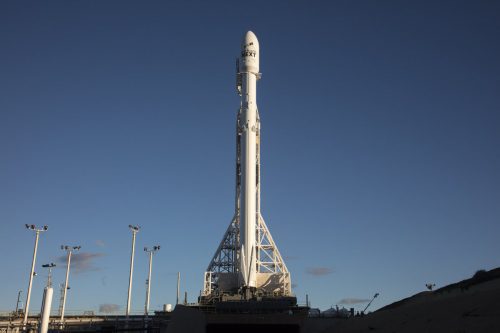
Then, on 1 September, just two days before the ninth Upgraded Falcon 9 of 2016 would have launched the Amos-6 communications satellite to GTO, disaster struck. During routine pre-launch operations on Space Launch Complex (SLC)-40 at Cape Canaveral Air Force Station, Fla., the vehicle and payload were destroyed in an explosion. As outlined by AmericaSpace’s Mike Killian in a recent article, investigators zeroed-in on a breach in the cryogenic helium system of the liquid oxygen tank aboard the Upgraded Falcon 9’s second stage. Attention was focused specifically on one of three Composite Overwrapped Pressure Vessels (COPVs) inside the tank itself and SpaceX provisionally announced plans to return to flight in mid-December, launching the first ten satellites of a contracted 70-strong booking with the Iridium global mobile telecommunications provider.
However, with Federal Aviation Administration (FAA) closure of the investigation—and permission to proceed with the launch—still pending, the flight found itself moved into early January. An initial target of the 8th was called off, reportedly due to high winds and rain at Vandenberg Air Force Base, together with “other range conflicts”, and a new No Earlier Than (NET) date of the 14th seemed likely. An uncertain week followed, with both SpaceX and Iridium tweeting confidently about this date, but no formal confirmation from Vandenberg that Western Range approval had been secured. Not until Friday afternoon, with the closure of the final FAA pre-flight conditions, did Vandenberg’s 30th Space Wing declare its readiness to support Saturday morning’s opening launch attempt.
By this stage, the 230-foot-tall (70-meter) Upgraded Falcon 9 had stood on Space Launch Complex (SLC)-4E at Vandenberg for more than a week, having smoothly wrapped up a customary Static Fire Test of its nine Merlin 1D+ first-stage engines. New rules implemented after the Amos-6 accident required the customer’s payload to be installed atop the booster after the Static Fire Test. As such, the ten Iridium NEXT satellites—housed in a special dispenser and encapsulated within a bulbous payload fairing—were loaded last weekend. On Friday, Iridium CEO Matt Desch tweeted an image of his company’s “ride to orbit”, standing proudly on SLC-4E.
Although today’s mission was the 29th launch of a Falcon 9, it was actually the ninth mission by the Upgraded version of the vehicle, which benefits from an enhanced suite of Merlin 1D+ engines on its first and second stages. First flown in December 2015, it can transport up to 50,300 pounds (22,800 kg) into low-Earth orbit and up to 18,300 pounds (8,300 kg) to GTO, which represents an approximately 72-percent performance hike over the capabilities of its predecessor, the Falcon 9 v1.1, which completed 15 missions between September 2013 and January 2016. And prior to that were five flights by the first-generation Falcon 9 v1.0 from June 2010 through March 2013. Unlike its v1.0 and v1.1 cousins, the Upgraded Falcon 9 benefits from the use of “densified” cryogenic propellants, which are chilled much closer to their freezing point and loaded much later in the countdown, normally from around T-35 minutes. This densification process also affords the vehicle a greater performance flexibility.
Due to the requirements of the Iridium NEXT payload, the launch window is an “instantaneous” one, with very limited margin to accommodate last-minute technical issues or changeable weather conditions. Saturday’s opening attempt was carefully timed for 9:54 a.m. PST, with a 60-percent likelihood of acceptable weather conditions at T-0. That forecast was expected to deteriorate to only 40-percent-favorable in the event of a scrub and 24-hour turnaround to a Sunday launch attempt.
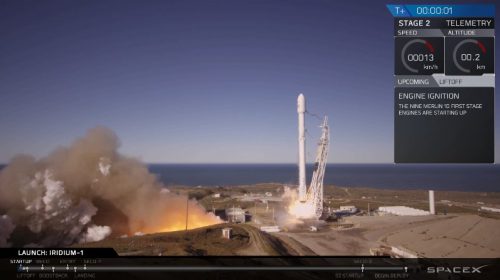
Early Saturday, the fueling of the Upgraded Falcon 9 got underway in a slightly different manner to previous flights, in light of findings from the Amos-6 investigation. “The fueling now occurs somewhat earlier in the countdown,” noted AmericaSpace’s Launch Tracker, “eliminating the rush in the last 30 minutes to get the rocket fueled and prepared for launch.” Instead of kicking off fueling at T-35 minutes, the loading of a highly-refined form of rocket-grade kerosene (known as “RP-1”) actually got underway at 8:50 a.m., more than an hour before launch. This was followed by the onset of liquid oxygen tanking at 9:15 a.m.
Backdropped by near-perfect weather conditions, with clear skies and calm winds, the only issues of note occurred in the final 15 minutes, when Range Safety reported that ship had strayed into the launch exclusion area. This was quickly shooed away and at 9:44 a.m. the terminal countdown autosequencer got underway at T-10 minutes. The nine Merlin 1D+ engines of the first stage—arranged in a circle of eight, with the ninth at the center—were chilled-down, ahead of ignition, and the SLC-4E strongback was retracted and the Flight Termination System (FTS) was armed. In the final minutes, the Upgraded Falcon 9 transitioned to internal power, and the Iridium NEXT payload was powered up, ahead of the vehicle assuming primary control of all critical functions at T-60 seconds.
Also at the one-minute mark in the countdown, the 53 nozzles of the Niagara deluge system flooded the SLC-4E launch pad with 30,000 gallons (113,500 liters) of water, per minute, to suppress the acoustic energy. Three seconds before liftoff, the nine Merlins roared to life, pumping out a combined thrust of 1.5 million pounds (680,000 kg). Liftoff occurred precisely on time at 9:54 a.m. PST.
Climbing smoothly into the crystalline Californian sky, the booster performed with its usual perfection, passing the point of maximum aerodynamic turbulence (colloquially dubbed “Max Q”) at 70 seconds into the ascent. A little more than two minutes after launch, the first stage shut down and separated from the rapidly climbing vehicle, whose second stage—powered by a single, restartable Merlin 1D+ Vacuum engine, with a thrust of 210,000 pounds (92,250 kg)—picked up the baton to deliver the ten Iridium NEXT satellites to orbit.
The first stage, of course, had another mission: to land smoothly on the deck of the Autonomous Spaceport Drone Ship (ASDS) in the Pacific Ocean. Although first-stage landings on drone ships have been attempted over the past two years, firstly in January 2015, it was not until April 2016 that an Upgraded Falcon 9 made a fully successful touchdown, in one piece, without toppling over. During the summer of 2016, three more first stages followed suit in similarly spectacular style, but all did so on the East Coast-based drone ship, nicknamed “Of Course I Still Love You”.
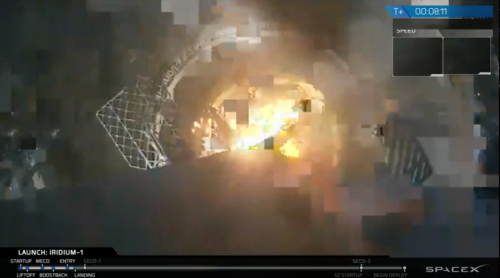
Meanwhile, SpaceX’s West Coast launch site at Vandenberg had only been used twice before this morning’s launch. It hosted the maiden voyage of the Falcon 9 v1.1 in September 2013 and, more recently, saw the Jason-3 ocean altimetry mission launch in January of last year. On its last flight, the West Coast-based drone ship, dubbed “Just Read the Instructions”, was positioned about 173 miles (278 km) south of Vandenberg, off San Diego, to receive the descending first stage. Although the stage reached the deck of the drone ship, one of its landing legs failed to properly latch into place and it toppled over and exploded.
Today’s mission, it was hoped, would see the very first successful first-stage landing for Just Read the Instructions. And that landing was truly spectacular. In contrast to several previous missions, which have been plagued by intermittent video communications, the entire descent from the edge of Earth’s sensible atmosphere to the deck of the ASDS was captured. The first stage was jettisoned from the remainder of the Upgraded Falcon 9 at 9:56 a.m. PST, some two minutes and 27 seconds after liftoff, and proceeded to deploy its four lattice-like grid fins. Configured in an X-wing layout, these served to control the lift vector, as the first-stage executed a trio of engine “burns” to flip itself over, adjust its rate of descent and finally—around eight minutes and 20 seconds after launch—bring itself to a smooth touchdown on the deck of Just Read the Instructions.
As the first stage stood proudly atop the drone ship, awaiting retrieval, the second stage continued its primary mission to deliver the Iridium NEXT satellites to their desired orbital slot. The first engine firing lasted 6.5 minutes, punctuated by the jettison of the payload fairing, and shutdown occurred at 10:03 a.m. The stack then coasted for around three-quarters of an hour, before the Merlin 1D+ Vacuum roared to life a second time at 10:46 a.m. This time, it burned for just three seconds, positioning its precious payloads for deployment. About an hour after launch, the first five Iridiums departed their dispenser, followed by the remainder about 15 minutes later. “Mission looks good,” tweeted SpaceX CEO Elon Musk at 11:05 a.m. “Started deploying the 10 Iridium satellites. Rocket is stable on the drone ship.”
However, ground station telemetry coverage prevented early confirmation that the Iridiums had been deployed. With some relief, confirmation came relatively quickly. “The last the Iridium NEXT satellites has just been released and all ten are now flying under their own power,” AmericaSpace’s Launch Tracker noted. “This completes the launch mission for SpaceX and commences the start of the operational checkout and integration for Iridium.” Current plans are for SpaceX to deliver the remaining 60 satellites to orbit, over six launches, by spring 2018, thereby fulfilling a $462 million contract with Iridium Corp., which was signed back in June 2010.
Be sure to “Like” AmericaSpace on Facebook and follow us on Twitter: @AmericaSpace




